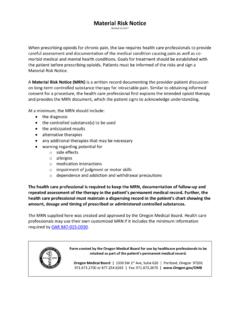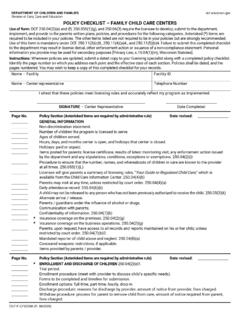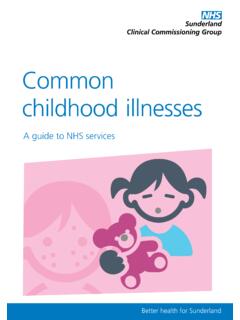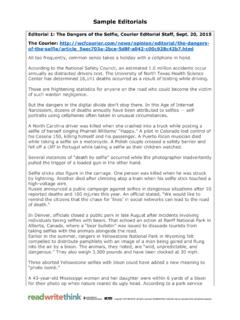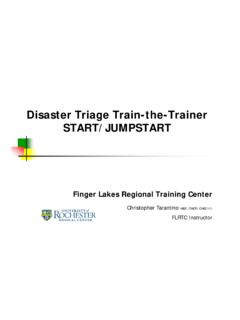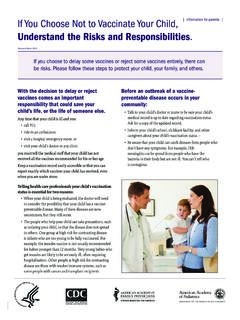Transcription of SPLINTING GUIDE FOR EMS/HOSPITAL PROVIDERS - …
1 SPLINTING GUIDE FOR EMS/HOSPITAL PROVIDERS INTRODUCTION (LOUIS SPINA , 9/2016) Splints can be applied to most pediatric fractures, dislocations and sprains. Splints may also aid in the immobilization of soft tissue injuries such as fingertip amputations and lacerations over joints where it is important to minimize tension or damage to the healing injury. Immobilization can decrease pain and bleeding as well as prevent further vascular, nerve and soft tissue damage. Unlike casts, which are circumferential, splints allow for swelling in the immediate post injury phase and can reduce the possibility of compartment syndrome. They can be used the primary modality for immobilization during the healing phase of an injury and can be used temporarily until swelling resolved and a cast can be placed definitively. Many recent studies in the pediatrics have demonstrated that removable splints for minor injuries such as torus fractures provide a faster return to baseline function when compared to traditional casting.
2 Temporary splints from transport can be used by emergency medical services. Splints can be made from a variety of materials. The most common form is plaster of Paris (powdered for gypsum impregnated in gauze. This has the benefit of being inexpensive and customized to the patient. Plaster typically sets in 2-8 minutes but does not reach maximum strength until 24 hours. Malleable aluminum, air and synthetic SPLINTING materials may also be used ( Fiber glass, Orthoglass). Synthetic SPLINTING materials are more difficult to mold and more expensive. However, they are lighter, set more quickly and are water resistant. Preformed splints for common uses are more readily available ( thumb spica). There preformed splints come in a variety of sizes but the appropriate size may not be available for smaller children. Preformed splints do not provide the same degree of immobilization as custom splints. Custom splits should be utilized when precise and continuous immobilization is required.)
3 EQUIPMENT 1. Stockinet (optional) 2. Plaster or fiberglass SPLINTING /casting material 3. Webril (splint padding) 4. Warm water (room temperature) 5. Elastic wrap, Tape, Sling COMPLICATIONS Cutaneous: pressure sores/necrosis, infection, thermal burns Neurovascular compromise PROCEDURE: SPLINTING PREPARE Clean, repair and dress any skin lesions prior to SPLINTING Consider removing clothing that will not be able to be removed after Evaluate neurovascular status SELECT Appropriate splint type (See table below) LENGTH Use unaffected extremity to measure the materials In general, the plaster is used to immobilize the joint above and joint below the injured area, if this is anatomically possible The stockinet should be longer than the splining material so that it can be rolled over the ends of the splints. Cut dry plaster or fiberglass to fit area to be splinted. Plaster of Paris should be slightly longer than needed as it retracts during setting WIDTH The size of the plaster used in measured to cover approximately 50% of the circumference of the injured extremity.
4 In an adult, this generally means 2 inch for the fingers, 3-4 inches for the upper extremity and 5-6 inches for the lower extremity LAYERS In an average sized adult, upper extremities should be splinted with 8-10 layers of plaster. Lower extremities generally require 12-14 layers. PADDING Roll Webril around stockinet. This should be about 2-3 layers thick & each turn should overlap the previous turn s with by 25-50% of its thickness. Alternatively, layers of Webril (approximately the number of layers as the plaster & the same diameter as the plaster) may be used One additional layer of Webril is placed on the outside of the plaster (non-skin side) to avoid sticking of the elastic wrap to the plaster. Place additional padding (Webril) over boney prominences (such as the ankle malleoli) to avoid pressure injuries . POSITION In general, splints are prepared to immobilize the effective limp in a position of function. See individual splints to follow. There are exceptions to this rule.
5 5th metacarpal neck fractures are position with the 5th MCP at 70-90 degrees. Distal finger extensor tendon avulsion leading to Mallet deformity are splinted in extension WET Wet plaster/fiberglass material (not the padding) Plaster of Paris and water create an exothermic reaction. The water should be at room temperature (ideally at 24 C) The plaster drying rate is directly related to water temperature. The colder the water, the longer the drying time. As the water temperature approaches 40 C, the potential for serious burns from the splint doubles. Squeeze out excess water. Lie the plaster on a flat surface and smooth out any lumps or wrinkles APPLY The Webril-lined splint is then positioned over the area to be immobilized Perform initial splint shaping at large joints. secured with an ACE wrap. Shape splint contours to final form. Maintain splint positioning until it has completely hardened. FINISH Re-evaluate and document neurovascular status Provide a sling for comfort (upper extremity) or crutches (lower extremity) SPLINT AFTERCARE The patient or parent should be advised to avoid wetting the splint and to not to place any objects between the skin and the splint.
6 The lower end of the splint should be elevated to avoid further swelling. For example, a sling on the upper extremity should be position so that the hand is above the level of the elbow. For lower extremity splints the foot should be elevated on a chair if sitting or a pillow if lying. Ice can be applied to the outside of the splint for pain but no longer than 15-20 minutes. They should return urgently for worsening pain under or distal to the splint. Numbness or paresthesias. Follow up should be arranged within a week with an orthopedist SPLINT SELECTION SPLINT INDICATION COMMENTS Upper Extremity Splints Colle s/Volar Distal forearm Alternative to sugar tong (not for young children) Long arm Gutter Wrist, forearm Metacarpal Proximal phalanx Radial for 2nd/3rd digits Ulnar for 4th/5th digits Sugar tong Elbow Proximal humerus Distal Useful for most upper extremity fractures Must use sling Thumb spica 1st metacarpal Proximal phalanx Scaphoid Lower Extremity Splints Long leg Distal femur Proximal tibia/fibula Crutches for children over 6 years Posterior (short) leg Distal tibia/fibula Foot Ankle Crutches for children over 6 years Stirrup Ankle (including soft tissue injuries ) Allows for weight bearing Fits in shoe RADIAL/ ULNAR GUTTER INDICATIONS Metacarpal and/or proximal phalangeal fractures.
7 Ulnar gutter splint immobilizes the plain of 4th and 5th digits. Radial gutter splint immobilizes plain of 2nd and 3rd digits. DIMENSIONS Width to wrap to midline of the hand on dorsal & volar surfaces. Length to extend from the nail base to the proximal forearm. POSITIONING Position patient with forearm vertically erect. Shape the splint as follows: Wrist in neutral position M-P joints in 70 flexion. P-I-P joints in 20-30 flexion. COMMENTS A thin layer of padding should be placed between the fingers to prevent irritation. Using a sling is optional to keep arm elevated (not feasible in toddlers & infants THUMB SPICA INDICATIONS A thumb spica splint is essentially a radial gutter splint adapted for immobilization of the thumb. Indicated for: Nondisplaced fractures of the first metacarpal bone. Nondisplaced fractures of the proximal phalynx of the thumb. Scaphoid fractures. Sprain of the ulna collateral ligament DIMENSIONS Dimensions are the same as for a radial/ulnar gutter splint.)
8 POSITIONING Wrist in neutral position. Thumb abducted & in slight flexion at the M-P and I-P joints. COMMENTS May also make small cuts in plaster/fiberglass on both sides at the base of the thumb to make it easier to wrap around thumb VOLAR /COLLES INDICATIONS Distal forearm and wrist fractures. Also immobilizes the plane of the 2nd and 3rd digits. DIMENSIONS Width to fully cover volar aspect of the forearm. Length to extend from proximal fingers to proximal forearm along volar side of forearm. POSITIONING Position wrist in neutral position and digits slightly flexed at all joints. COMMENTS Using a sling is optional to keep arm elevated (not feasible in toddlers & infants) May be extended to distal fingertips for distal finger fractures or metacarpal fractures of the fingers/metacarpals 2-4. LONG ARM POSTERIOR INDICATION Used for stable injuries in the elbow region. For example, the patient with elbow pain in which no obvious fracture is seen but a joint effusion is present as evidence by an enlarged posterior fat pad.
9 (Orthopedic consults are needed for supracondylar fractures) DIMENSIONS Width to cover the arm circumference. Length to extend from the dorsal aspect of the mid-upper arm, over the olecranon, and down the ulnar aspect of the arm to the distal palmar flexion crease. POSITIONING Position the child on his/her stomach with injured arm hanging off stretcher with elbow at 90 angle After plaster/fiberglass is applied, shape the splint with elbow flexed at 90 and forearm in neutral position. COMMENTS To ensure comfort, provide extra padding to any bony prominence. A sling must be worn to support the arm because many casting materials cannot maintain the 90 angle needed at the elbow. SUGAR TONG (ARM) INDICATIONS Broad range of uses. Proximally, it can be used for stable humerus fractures. Distally, frequently used for stable forearm and wrist fractures provides the most effective immobilization in these areas. A double sugar tong (both proximal and distal at a 90 degree angle at the elbow) can be used to immobilize elbow injuries .
10 DIMENSIONS Width of the distal splint should slightly overlap the radial and ulnar edges of the arm. Length should extend from the dorsal aspect of the knuckles, around the elbow, to the volar palmar flexion crease. POSITIONING Position the child on his/her stomach with injured arm hanging off stretcher with elbow at 90 angle After plaster/fiberglass & overwrap is applied, shape splint and keep elbow flexed at 90 with the wrist in neutral position. COMMENTS A sling is necessary to support the sugar tong at the elbow. Analogous to a ankle stirrup splint POSTERIOR / SHORT LEG INDICATIONS Provides support for injuries in: Distal tibia/fibula Ankle Foot DIMENSIONS Width should cover at least the leg circumference. Length should extend posteriorly from level of the fibular neck over the heel of the foot to the base of the toes. POSITIONING To apply, position child prone on a stretcher with knee flexed at 90 degrees. The foot should be placed in neutral position at 90 to the leg.









